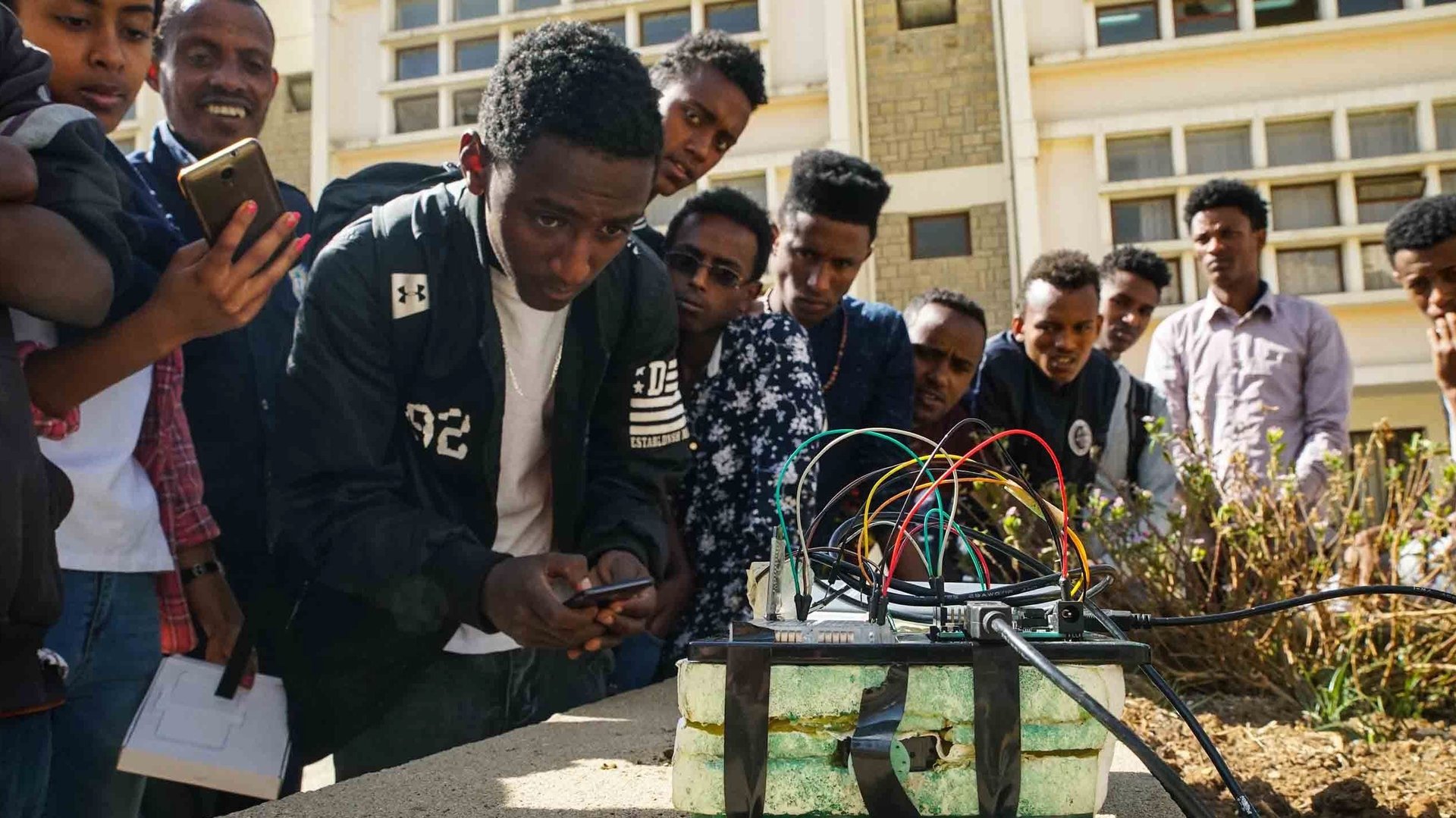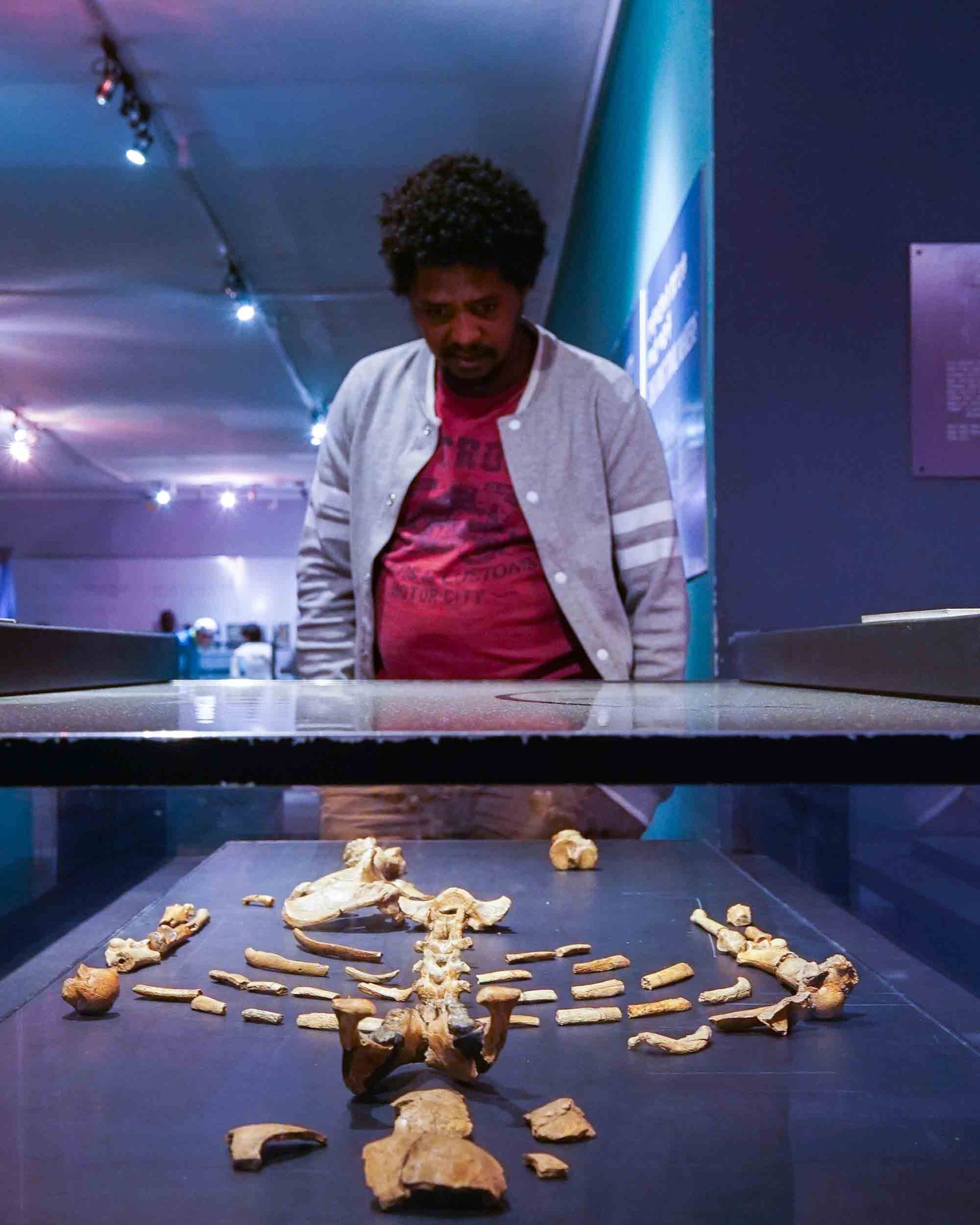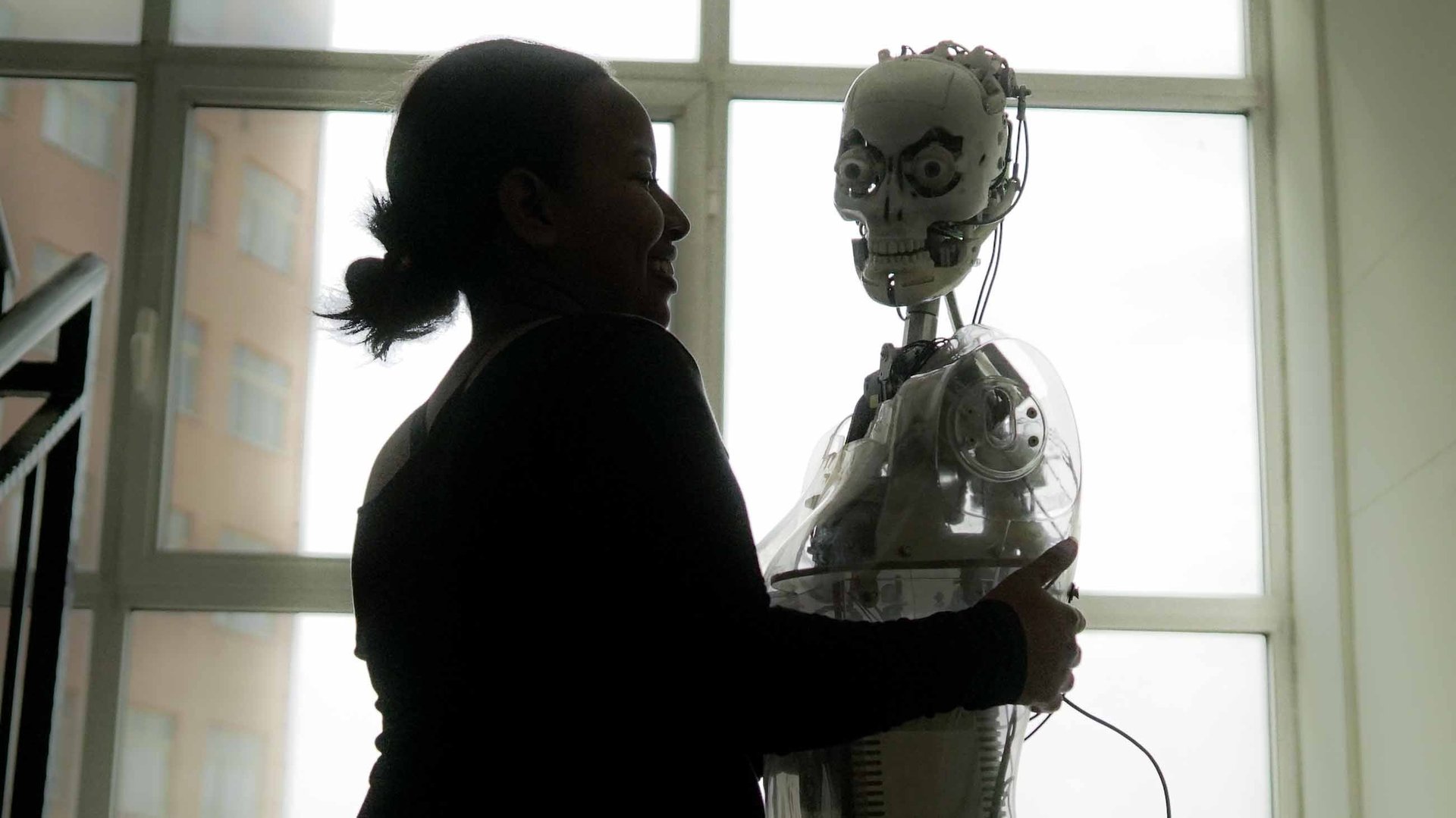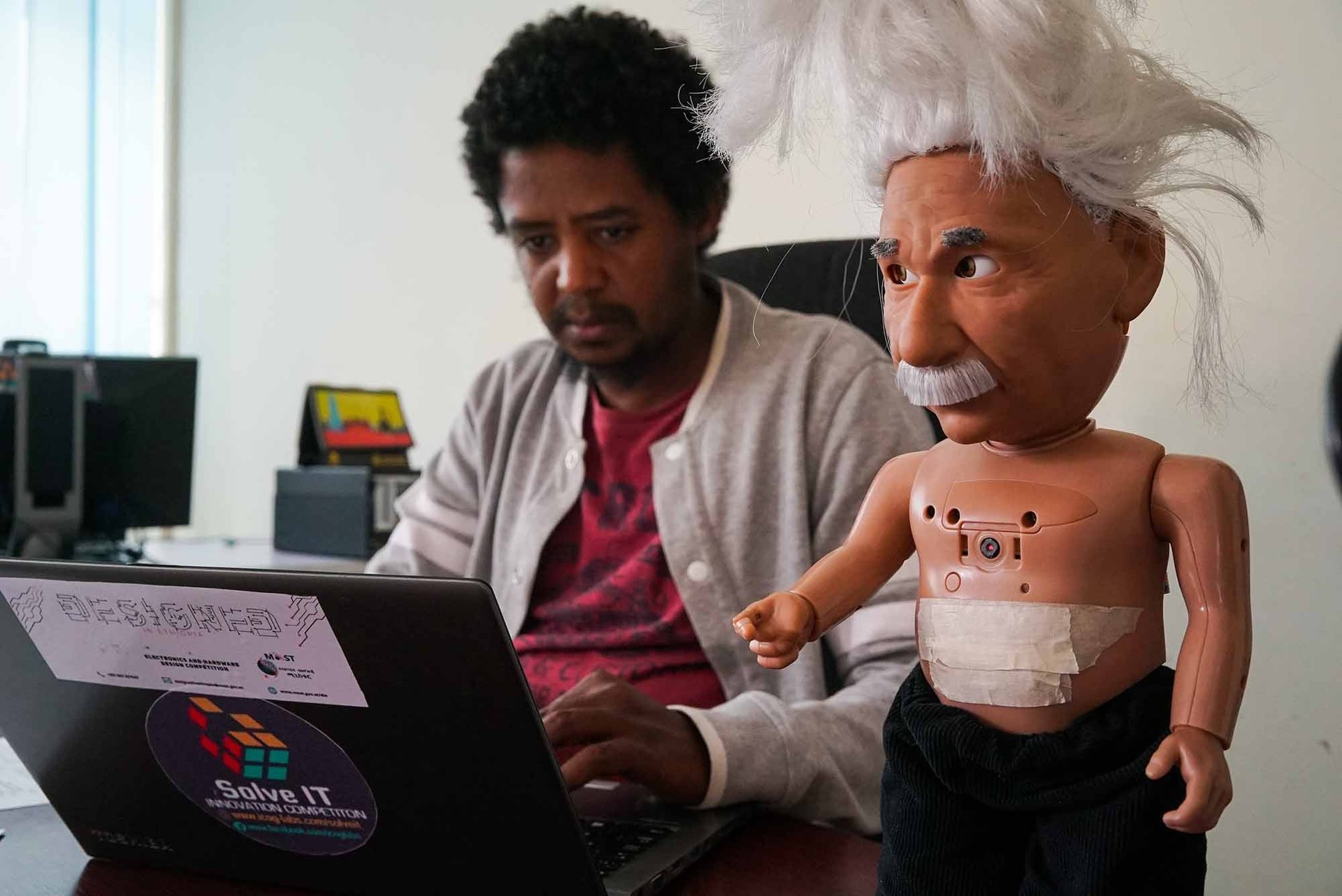Futurists in Ethiopia are betting on artificial intelligence to drive development
“I don’t think Homo sapiens-type people will exist in 10 or 20 years’ time,” Getnet Assefa, 31, speculates as he gazes into the reconstructed eye sockets of Lucy, one of the oldest and most famous hominid skeletons known, at the National Museum of Ethiopia. “Slowly the biological species will disappear and then we will become a fully synthetic species,” Assefa says.


“I don’t think Homo sapiens-type people will exist in 10 or 20 years’ time,” Getnet Assefa, 31, speculates as he gazes into the reconstructed eye sockets of Lucy, one of the oldest and most famous hominid skeletons known, at the National Museum of Ethiopia. “Slowly the biological species will disappear and then we will become a fully synthetic species,” Assefa says.
“Perception, memory, emotion, intelligence, dreams—everything that we value now—will not be there,” he adds.

Assefa is a computer scientist, a futurist, and a utopian—but a pragmatic one at that. He is founder and chief executive of iCog, the first artificial intelligence (AI) lab in Ethiopia, and a stone’s throw from the home of Lucy. iCog Labs launched in 2013 with $50,000 and just four programmers. Today, halfway up an unassuming tower block, dozens of software developers type in silence. Their desks are cluttered with electronic components and dismembered robot body parts, from a soccer-playing bot called Abebe to a miniature robo-Einstein. An earlier prototype of Sophia, a widely recognized humanoid robot developed by Hong Kong-based company Hanson Robotics (she appeared with late-night talk show host Jimmy Fallon last year) is here too. Arguably the world’s most famous robot of her kind, Sophia’s software was partly developed here in Ethiopia’s capital.
In stark contrast to the famine-stricken images that linger in the minds of many Westerners, Addis Ababa has, in recent years, become a hub for international business and diplomacy. Glitzy new office blocks and hotels continue to rise across the sprawling capital, and while Ethiopia is still ranked among the world’s poorest countries in terms of GDP per capita, it is also among the fastest growing.
Assefa hopes to place artificial intelligence at the heart of Ethiopia’s rapid development, but he receives little backing from the government, which has been encouraging investment in the manufacturing sector. “They think that advanced technologies are a luxury,” he sighs, as we sit in the Lucy-themed restaurant next door to the museum. “It’s not a luxury, it is crucial.”
His logic might not seem immediately obvious in a country like Ethiopia, which is once again facing a food crisis. Throughout history, development has tended to follow a well-trodden path, with employment moving from farm to factory, and then from factory to the office. Such was the trajectory for the rapidly developing economies of East Asia—South Korea, Taiwan, Hong Kong, Singapore, Malaysia, Thailand, and Indonesia—in the 1970s and 80s.
But this path to development may make less sense in an age of digital ubiquity—in part due to what futurist Ray Kurzweil has called the Law of Accelerating Returns, which holds that as technology advances at an exponential rate, so does its impact on society. “One can argue that information technologies are far more disruptive than industrial technologies were,” explains J.P. Singh, a professor of culture and political economy at the University of Edinburgh. “It took a long time for industrial technologies to diffuse all over the world, and in some places it still hasn’t happened — but mobile telephony is almost ubiquitous.”
Artificial intelligence is the latest technology sweeping the world, and consultancy firm McKinsey predicts that up to 30% of the global workforce could be displaced by 2030 because of advances in AI, robotics, and digitization. And that’s why Assefa and other stakeholders think Ethiopia would do better to skip the manufacturing stage of development and invest instead in a high-tech workforce—including one at the cutting edge of AI. This, he argues, would help Ethiopians find a new path to development by riding the wave of technological disruption.
“We should not start from steam and railways, or the old technologies—that is already done,” Assefa argues.

That makes sense to academics like Singh — though he also cautions that political forces are often slow to see the bigger picture. There is definitely an opportunity for developing countries, he says. “But any time we have a technological revolution, the political institutions have to catch up.”
A 2017 report (pdf) by the World Wide Web Foundation suggested that Ethiopian “intelligence services are using machine intelligence techniques to break encryption and find patterns in social media posts that can be used to identify dissidents.” And while mobile phone and internet penetration in Ethiopia is comparatively poor—a situation made worst amid widespread anti-government protests, which prompted an internet crackdown in February — the report added that government surveillance and oppression could increase as the use of smartphones expands.
But where some people see artificial intelligence as a threat, Assefa sees it as an opportunity. He grew up playing with household appliances, learning first-hand how they solve problems and wondering why technology was not more evenly distributed: “I was curious about robots and automation: Why are people farming? Why don’t they just use machines and other inventions?” By teaching Ethiopians how to use AI technologies he hopes to equip them to find their own path to development.
Solve IT is a nationwide program launched by iCog this year that teaches young Ethiopians the essentials of computer coding, hardware, and entrepreneurship—challenging them to find technology-based solutions to community problems. “We used to hear about the invention of artificial intelligence, how it would be useful for people, but there aren’t many products made with that here in Africa,” says 20-year-old Yonathan Amaniel, a student at Mekelle University in the far north of Ethiopia. “In developed countries they make home assistants. We don’t need products to make our lives more comfortable, we need products to survive,” he tells us by a dusty roadside on the outskirts of the city. Under his arm is an early prototype for a self-driving tractor that he and his classmates have been working on.
Team member Bisrat Seyoum comes from a family of subsistence farmers. “My father told me that ploughing using just human power and ox power is so difficult. It uses so much energy and it’s still not enough to make a profit from,” he says. The students hope their self-driving tractor will one day ease the struggle of many Ethiopian farmers. He and other students envision tractors outfitted with advanced sensors that avoid obstacles, plan farming, and detect soil moisture.

The benefits could go beyond economics in Ethiopia—a communal culture where traditionally people spend several hours a day drinking coffee together. “If work is given to robots, we can really experience what being human is,” suggests Betelhem Dessie, one of Solve IT’s project coordinators. “We are social animals, we’re dependent on others, but we’re not really doing that currently.”
But the team’s futuristic tractor is ambitious, and they are clearly a long way from its realization. Like Seyoum’s family, most farmers in Ethiopia have no access to a tractor, let alone one outfitted with AI. More broadly though, as the price of computing power continues to plummet artificial intelligence is becoming accessible to Ethiopians. “If you have a laptop and a brain you can do AI,” says Assefa. “Oh, and an internet connection.”
Watching over the young AI-enthusiasts is software engineering student Eman Asfaw, who at 22 is barely older than the group she is training. Though she shares their youthful enthusiasm and energy—laughing with the rest as the tractor prototype awkwardly stops and starts—she is clearly wise beyond her years. Like most Ethiopians, Asfaw is proud of her country’s anti-colonial history and distinct, ancient culture. This includes the Amharic language.
“One of the coolest things I can imagine is Amharic natural language processing (NLP) built and integrated with Sophia the Robot!” she exclaims. “I believe it can inspire the Ethiopian youth to actually get really engaged in AI and feel like it’s their thing.”
“I want to see more youth getting inspired by NLP,” to create “sophisticated software that would help the average Ethiopian,” she adds.
But Asfaw’s aspirations do face a new sort of colonialism. Silicon Valley’s tech giants have near monopoly control over the world’s data—information that is often used as the foundation for machine learning and the development of artificial intelligence applications.
“Digital colonialism is the new deployment of a quasi-imperial power over a vast number of people, without their explicit consent,” explains Renata Avila of the World Wide Web Foundation. For Avila, “going local” is the logical way to subvert this: from decentralized social media to AI programmed in indigenous languages, by indigenous people — without the learned racial or gender biases observed in existing AI systems.
“Instead of one-size-fits-all AI,” Avila says, “we could be placing the developments closer to the people and empowering local communities to both participate in its design, benefit from the data they generate and increase the accountability of the systems serving them.”

That’s at the heart of another of Assefa’s projects, called YaNetu. It is a virtual, open-source, Amharic-speaking AI teacher based on the same software as Sophia the robot. Assefa hopes that YaNetu will one day disrupt education systems in the world’s developing countries.
“For the kid in Africa, the cost of a tablet will become the same as a book; one kilogram of silicon will be equal to one kilogram of paper,” Assefa explains. And instead of rote-learning and one-size-fits-all syllabi, those tablets could be outfitted with a localized, linguistically appropriate version of YaNetu, which would be capable not just of teaching, but of learning the child’s interests, abilities, and learning style— adapting her teaching approach accordingly.
In only five years, the team working to develop YaNetu has multiplied 20-fold, and they already boast clients like Huawei, Hershey Foods, and even Hanson Robotics, the creators of Sophia.
But without government support and additional investment, Assefa worries that the embryonic high-tech and AI movement he’s attempting to foster in Ethiopia will remain a mere shadow of those in Silicon Valley and East Asia. “Google is investing [in AI], Facebook is investing, the Russian government is investing, the Chinese Communist Party is investing,” Assefa says.
“Not a hundred thousand dollars like us,” he adds with a smile, “but a million billion dollars.”
This article was originally published on Undark. Read the original article.
This article is part of Quartz Ideas, our home for bold arguments and big thinkers.